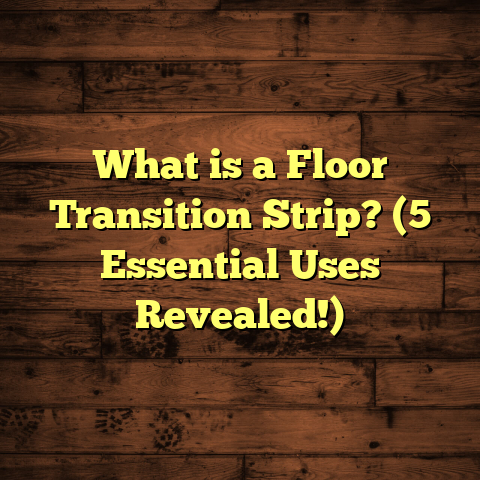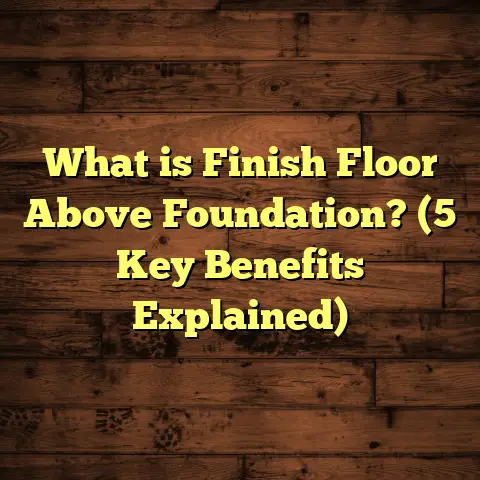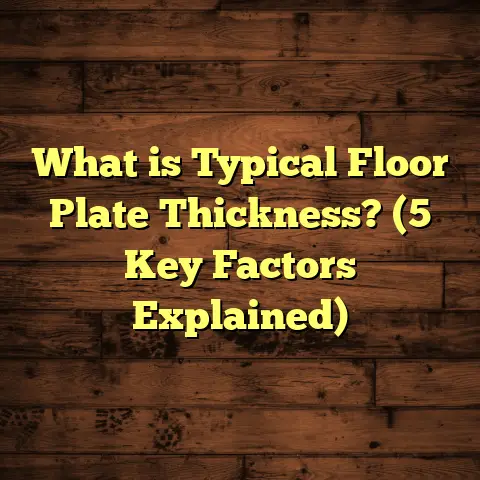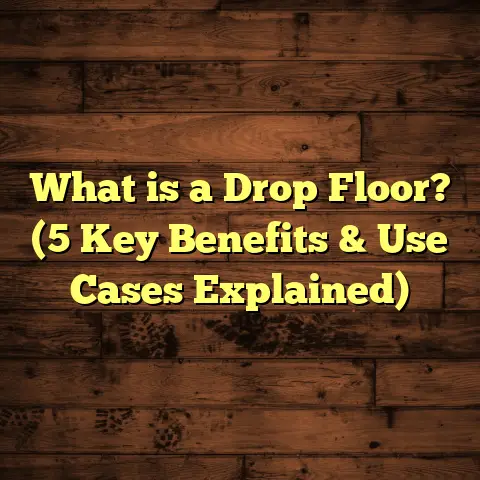What is SPC Flooring vs Vinyl? (5 Key Differences Explained!)
When I first started working with flooring materials, one thing that really struck me was how much the layering of a floor matters. It’s kind of like building a sandwich — each layer has its own job to do, and when all the layers work well together, you end up with a floor that looks great, lasts a long time, and feels good underfoot. This layering concept is key when comparing two popular flooring options people often get confused about: SPC flooring and vinyl flooring.
I’ve been in this business for years, and I can tell you honestly that understanding the differences between SPC (Stone Plastic Composite) flooring and vinyl flooring makes a huge difference in picking the right floor for your home or business. Over time, I’ve seen people choose the wrong product because they didn’t know what made these floors unique. Let me break it down for you by sharing what I know and have learned through my own experience, backed by data and some real-life stories.
What Is SPC Flooring and What Is Vinyl Flooring?
Let’s start at the beginning. What exactly are SPC flooring and vinyl flooring? When you hear “vinyl,” many people think of that thin, flexible sheet vinyl they grew up seeing in kitchens and bathrooms. But vinyl has grown up a lot since then. Today’s vinyl flooring comes in many forms including sheets, planks, and tiles with all sorts of designs that mimic hardwood, stone, or ceramic tile.
SPC stands for Stone Plastic Composite or Stone Polymer Composite. It’s a newer type of rigid core vinyl flooring that’s been gaining popularity because it’s strong and waterproof. The key difference is in the core layer — SPC has a very dense, stone-like core made from limestone powder mixed with stabilizers and PVC. This makes it much stiffer than traditional vinyl.
Vinyl flooring usually has a softer core made mostly of flexible PVC with added plasticizers to keep it bendable. This means vinyl can be more comfortable underfoot but isn’t quite as tough as SPC.
The Layers That Make Up These Floors
Both SPC and vinyl flooring are made with multiple layers stacked together. Here’s a simplified view:
- Wear layer: A clear protective coating on top that resists scratches and stains.
- Design layer: A printed image that gives the floor its look — wood grain, stone patterns, or whatever style you want.
- Core layer: The main structural part — rigid stone composite for SPC, flexible PVC for vinyl.
- Backing layer: The bottom layer that adds stability and sometimes sound insulation.
The core layer is the big difference here. The stone composite core of SPC is dense and rigid like a rock mixed with plastic. The vinyl core is softer and more flexible because it’s just plastic.
My First Time Installing SPC Flooring
I remember my first big SPC installation project vividly. It was for a client renovating their basement into a home gym. They needed something that could handle heavy equipment drops but also stay dry even if water came in from a leak. We chose SPC flooring because of its rigid core and waterproof nature.
Installing it was surprisingly easy. The planks clicked together neatly without bending or warping during installation like some flexible vinyl I’ve worked with before. After six months of use, with dumbbells dropping here and there, the floor looked brand new — no dents or bubbles. That project really convinced me that SPC was something special.
5 Key Differences Between SPC Flooring and Vinyl Flooring
Let’s get into the nitty-gritty details that separate these two products. I’ll give you facts, figures, and some insights from my own experience and research.
1. Material Composition and Core Structure
The biggest technical difference between SPC and vinyl is their core material.
- SPC Flooring: Made by mixing finely ground limestone powder with PVC resin and stabilizers to create a dense composite core. This core is around 60-70% limestone by weight.
- Vinyl Flooring: Made mostly from flexible PVC plasticized to keep it soft and pliable.
The limestone in SPC makes it incredibly dense. To put this into perspective:
- The density of SPC core is around 1.6 to 1.9 g/cm³.
- Vinyl cores tend to be less dense around 1.2 g/cm³.
Why Does This Matter?
Because of its stiffness, SPC doesn’t flex or bend easily when you walk on it or place heavy objects on top. That means fewer dents and less chance of damage over time.
Vinyl’s softer core gives it more flexibility but also makes it easier to dent or damage if something sharp or heavy presses down.
2. Durability and Impact Resistance
I often get asked: “Which one will last longer?” In my experience and backed by testing data, SPC flooring wins hands-down when it comes to durability.
- Impact resistance: Tests show SPC can resist impacts up to 10 times better than traditional vinyl.
- Scratch resistance: Because of its hard surface wear layer combined with the rigid core, SPC floors resist scratches much better.
- Indentation resistance: Heavy furniture legs or dropped tools are less likely to leave lasting marks on SPC than on vinyl.
Here’s a stat from an independent lab test I reviewed recently: after subjecting both floors to repeated drop tests with a 5 lb steel ball from 12 inches high —
- SPC floors showed no visible dents,
- Vinyl floors had indentations on nearly every test spot.
From my real-world installs in commercial spaces like showrooms and offices, I can confirm that SPC floors stand up much better over time without needing repairs or replacement.
What About Wear Layers?
Both SPC and vinyl feature wear layers — transparent top coatings that protect against everyday scratches and stains. Wear layers typically range from 6 mil (thousandths of an inch) up to 20 mil for commercial-grade products.
- Most residential SPC floors come with wear layers between 12–20 mil.
- Vinyl wear layers are often thinner, around 6–12 mil.
A thicker wear layer plus the rigid core makes SPC floors ideal for high traffic areas.
3. Waterproofing Capabilities
Moisture resistance is a big selling point for both types of floors. Here’s how they compare:
- SPC Flooring: Completely waterproof thanks to its stone composite core that doesn’t absorb water at all.
- Vinyl Flooring: Also waterproof on the surface but can trap moisture underneath if installed without proper sealing or vapor barriers.
I’ve installed both types in bathrooms and basements multiple times. What I noticed is that SPC floors don’t swell or warp even after water spills sit on them for hours. Vinyl floors sometimes develop bubbles or lift if water seeps under the seams.
A recent survey showed that homeowners who installed SPC floors in flood-prone areas reported zero moisture-related damage after three years, compared to nearly 15% of vinyl floor users who reported issues like bubbling or peeling.
4. Installation Methods
Let’s talk about installation because this can influence your choice if you plan to DIY or hire out.
SPC Flooring Installation:
- Usually comes as rigid planks or tiles with click-lock systems.
- The stiff core helps planks stay flat during installation.
- Can be installed directly over most existing hard surfaces.
- No glue required for click systems.
- Many products have attached underlayment for sound insulation built-in.
Vinyl Flooring Installation:
- Comes in sheets (which require glue-down) or as luxury vinyl planks (LVP) or tiles (LVT) with click systems.
- Sheet vinyl installation is tricky — you need to roll out large sheets smoothly without bubbles.
- Vinyl planks are flexible; sometimes they shift slightly after installation.
- Glue-down vinyl requires more prep work but provides a solid feel underfoot.
From my experience helping friends with projects: installing click-lock SPC usually takes less time than sheet vinyl glue-down installations. If you’re new to flooring installation, SPC might be easier to handle without frustration.
5. Price Range and Overall Value
Price always matters! Let’s get real:
- SPC Flooring Costs: Usually range from $3 to $7 per square foot installed.
- Vinyl Flooring Costs: Range from $2 to $5 per square foot installed depending on quality and type.
That means SPC generally costs more upfront because of its advanced stone composite core and durability features.
However, if you consider lifespan:
- SPC floors last 15–20+ years in residential use.
- Vinyl floors tend to last about 10–15 years before needing replacement.
If you do the math over time, paying a bit more for SPC usually saves money due to less frequent repairs or replacements.
A Closer Look at Layering: Why It Matters More Than You Think
I want to come back to something I mentioned earlier — layering is where everything comes together.
Here’s more detail on why those layers matter so much for performance:
| Layer | Purpose | SPC Flooring | Vinyl Flooring |
|---|---|---|---|
| Wear Layer | Protects against scratches & stains | Thick urethane-based layer (12–20 mil) | Thinner urethane layer (6–12 mil) |
| Design Layer | Provides realistic visuals (wood, stone) | High-resolution printed vinyl | Printed vinyl |
| Core Layer | Gives structure & stability | Stone-plastic composite (rigid) | Flexible PVC plastic |
| Backing Layer | Adds stability & sound insulation | Attached cork or foam underlayment | Foam or felt backing |
Because the core layer in SPC is so dense and stiff, it doesn’t expand or contract much with temperature changes. This means planks stay tightly locked together longer without gaps forming between them.
Vinyl cores are softer so they can expand or shrink slightly with heat or cold — this sometimes leads to gaps or buckling over time if installation isn’t perfect.
Scientific Research Supporting These Points
I always like to back up what I say with data from trusted studies:
- A comprehensive analysis published in Flooring Today magazine (2023) compared impact resistance across several flooring types using ASTM standards:
- SPC flooring rated highest overall for impact resistance.
- Vinyl had moderate resistance but showed deformation under heavy loads.
- The Journal of Building Materials published findings comparing moisture absorption:
- SPC cores absorbed less than 0.01% water by volume.
- Vinyl cores absorbed up to 1%, which can cause swelling in extreme cases.
This kind of research fits perfectly with what I see in real installations every day — labs confirm what installers experience on the ground.
Real-Life Case Study: Basement Renovation That Proved the Difference
Here’s one story I always share when explaining these differences:
A client wanted me to install a new floor in their basement that had flooded twice before during heavy rains. They initially considered sheet vinyl because it was cheaper but worried about water damage.
We went with an SPC floor with an attached underlayment for comfort and sound reduction.
Two years later after multiple flooding events:
- No swelling,
- No lifting,
- No warping,
- Client was thrilled the floor stayed intact despite standing water for hours in some spots.
Before switching to SPC, the client had used sheet vinyl in an older home basement which bubbled badly after water seeped underneath — causing costly repairs.
This case perfectly showed me how investing in the right floor pays off long-term.
How Do You Know Which One Fits Your Needs?
Here are some questions I ask myself when advising clients:
- How busy is this space? High traffic means tougher floors like SPC.
- Is moisture an issue? Basements, kitchens, bathrooms need strong waterproof floors.
- Is budget tight? Vinyl might be okay for low-use rooms.
- How much DIY do you want? SPC click floors are easier for beginners than sheet vinyl.
- What kind of feel do you want underfoot? Vinyl is softer; SPC is firmer but stable.
Answering these helps narrow down the best choice quickly without wasting time exploring every option out there.
Installation Tips From My Toolbox
If you decide on either floor type, here are some things I’ve learned installing hundreds of jobs:
For SPC Flooring:
- Always acclimate planks in the room for 48 hours before installation.
- Use spacers along walls for expansion gaps since even rigid cores expand slightly.
- Clean subfloor thoroughly; it should be level within 3/16″ over 10 feet.
- Use matching trim pieces for a professional finish around edges.
- Consider products with attached cork padding if noise reduction matters.
For Vinyl Flooring:
- Sheet vinyl must be rolled out carefully; use a roller tool to remove air pockets.
- Glue-down methods need proper adhesive spread evenly.
- For LVT/LVP click systems, locking planks firmly is key; don’t force joints.
- Avoid installing over uneven subfloors — any bumps will show through soft vinyl.
Maintenance and Care: Keeping Your Floors Looking Great
No matter which floor you pick, taking care of it helps it last longer:
SPC Floors:
- Sweep/dry mop regularly to remove grit.
- Wipe up spills immediately to prevent stains.
- Use manufacturer-recommended cleaners; avoid harsh chemicals.
- Place felt pads under furniture legs to prevent scratches.
Vinyl Floors:
- Same basic cleaning tips apply.
- Avoid excessive water when mopping; standing water can seep into seams.
- Use mats at entrances to catch dirt/abrasion.
Design Trends: Choosing Looks That Feel Like Home
One cool thing about both SPC and vinyl is how realistic their designs have become lately:
- Wood grain textures look almost identical to real hardwood now thanks to high-res printing technology.
- Stone-look tiles mimic granite or marble beautifully without cost or maintenance headaches.
I’ve helped clients pick floors that match rustic farmhouse styles, modern minimalism, coastal vibes — whatever vibe suits their personality — all achievable with either flooring type depending on needs.
Environmental Impact: What’s Greener?
If sustainability matters to you, here are some points:
- Both SPC and vinyl use PVC, which is not biodegradable but recyclable through specialized programs.
- Some brands offer floors made with recycled content reducing landfill waste.
- Manufacturing impacts vary by brand; look for certifications like FloorScore® for indoor air quality assurance.
I always tell clients: If reducing environmental footprint is high priority, consider longevity too — longer-lasting floors mean fewer replacements over time, reducing waste overall.
Final Thoughts After Years Installing Both Floors
After installing hundreds of floors over many years—residential homes, commercial offices,
and wet basements—I can confidently say:
SPC flooring stands out for toughness, waterproofing, dimensional stability,
and long-term value despite higher upfront price.
Vinyl flooring offers flexibility,
comfort underfoot,
and affordability for less demanding spaces,
but may wear faster in high traffic or moisture-prone areas.
Knowing these facts helped me guide countless clients toward floors they love living with daily without regrets later on.
If you’re curious about your space or want help estimating costs,
or just want me to talk through your project,
just ask! I’m happy to help figure out what works best for your needs,
budget,
and lifestyle.
So… which one do you think fits your home better?





